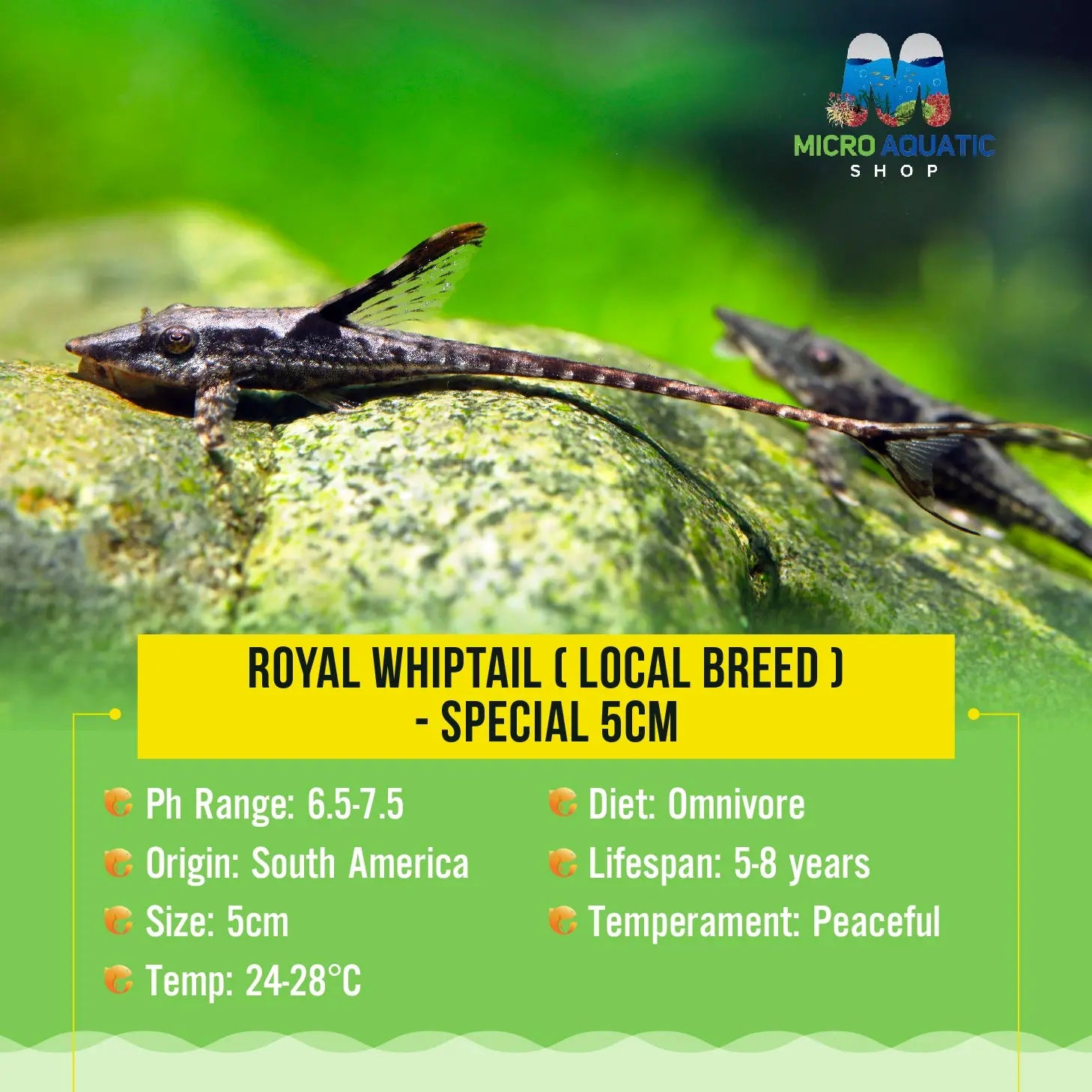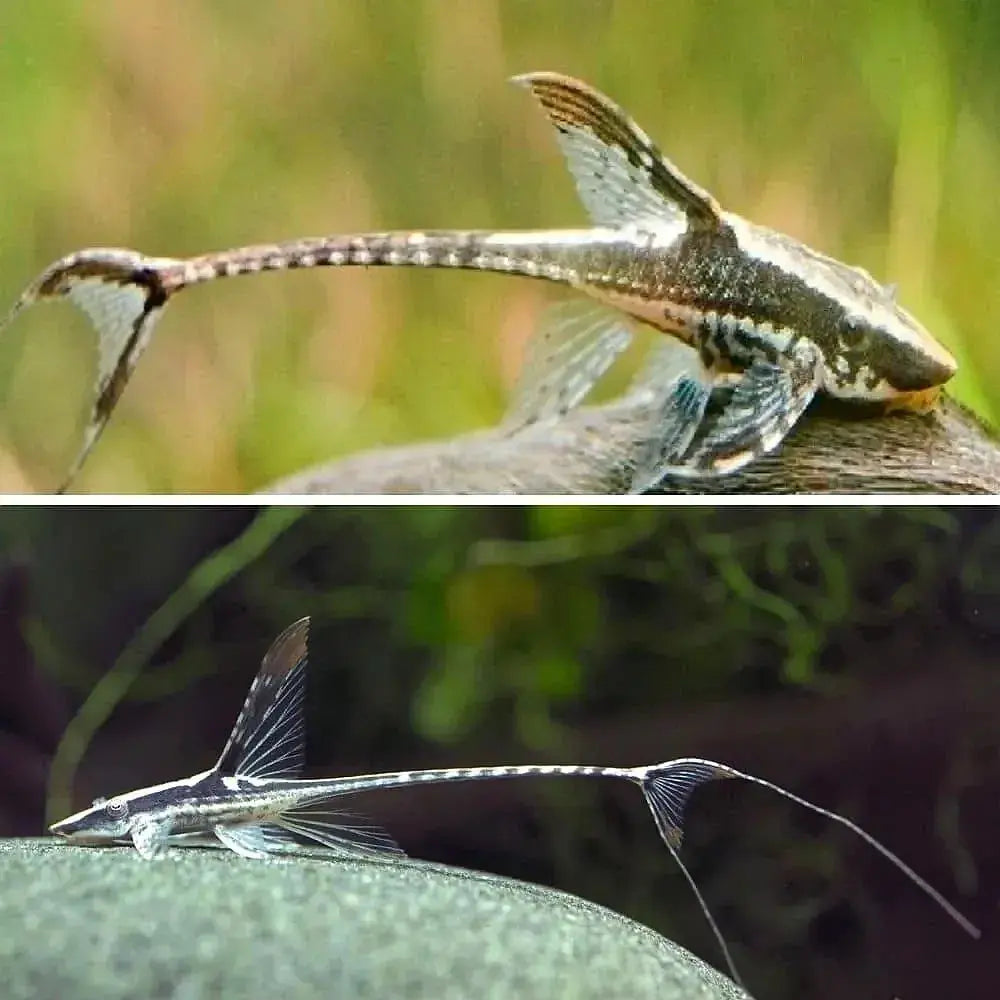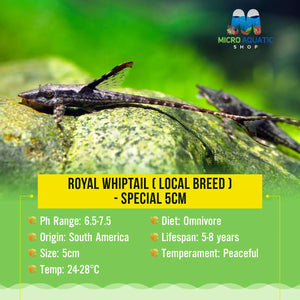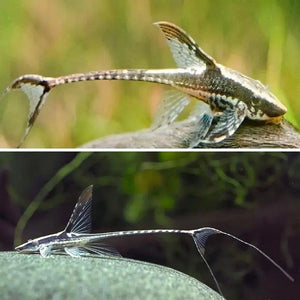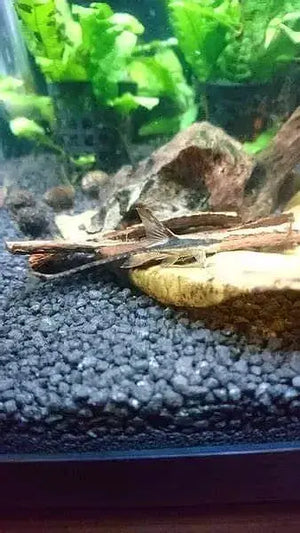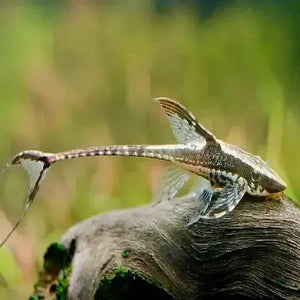Rare - Royal Whiptail 7cm
Guarantee Safe Checkout
Royal Whiptail Catfish - Stunning and Hardy Fish for Tanks
We're excited to share with you the Royal Whiptail Catfish. This tropical fish is a real showstopper in the world of freshwater aquariums. Its striking looks and hardiness make it a favorite among aquarium lovers.
Royal Whiptail Catfish with a slender body and long, whip-like tail, resting on driftwood.
These catfish are known for their long, whip-like tails and beautiful patterns. They're loved by many in Australia for being easy to care for. They fit well in different types of tanks, from community setups to special biotopes.
Key Takeaways
-
Stunning and hardy tropical fish for freshwater aquariums
-
Distinctive whip-like tails and striking patterns
-
Versatile and adaptable, suitable for various tank setups
-
Popular among Australian aquarium enthusiasts
-
Easy to care for and maintain in a well-established aquarium
Understanding the Royal Whiptail Catfish: Species Overview and Natural Habitat
The Royal Whiptail Catfish is a fascinating catfish known for its unique look and toughness. We'll look into its physical traits, where it lives naturally, and its conservation status.
Physical Characteristics and Unique Features
The Royal Whiptail Catfish has a long body and a special whip-like tail. This makes it stand out from other catfish. Its slender shape and delicate fins make it look graceful and captivating.
The fish's colour can be light grey to deep brown. It has detailed patterns that make it even more beautiful.
Natural Habitat and Behaviour in the Wild
In the wild, Royal Whiptail Catfish live in South America's rivers and streams. They are found in places like the Amazon basin. These areas have strong currents, lots of plants, and different ground types.
In the wild, they swim together in groups. This behaviour is important for their ecosystem.
Distribution and Conservation Status
The Royal Whiptail Catfish is found in many South American countries. But, their numbers are going down because of habitat loss and pollution. This has made them "Near Threatened" on the IUCN Red List.
The Royal Whiptail Catfish with its elongated body and pointed tail swims among green aquatic plants, highlighted by its distinctive colors and intricate patterns.
This shows how crucial it is to care for them and protect their homes.
|
Species |
Natural Habitat |
Conservation Status |
|
Royal Whiptail Catfish |
Rivers and streams in South America, particularly the Amazon basin |
Near Threatened |
Setting Up the Perfect Tank Environment for Royal Whiptail ,Catfish
Creating the perfect home for our Royal Whiptail Catfish is an exciting task. We need to think about their natural habitat and add key elements to our tank. Let's explore the basics of setting up a great environment for these freshwater friends.
Mimicking the Natural Habitat
The Royal Whiptail Catfish comes from the calm rivers and streams of South America. We should have a big tank of at least 75 gallons. The tank should have soft, sandy substrate for them to burrow.
Adding lots of live plants and driftwood is also important. These provide hiding spots and places for them to forage. This helps them feel at home in their aquarium.
Optimal Water Conditions
Keeping the water right is key for our catfish's health. We should keep the water temperature between 22.2-27.8°C (72-82°F). The pH should be slightly acidic, between 6.0-7.5.
Regular aquarium maintenance is vital. This includes changing some water and using good filters. It keeps the water clean and healthy for them.
Essential Equipment
-
High-quality filtration system to keep the water clean and well-oxygenated
-
Reliable heater to maintain the desired water temperature
-
Adequate lighting to support the growth of live plants and mimic their natural environment
By choosing the right tank design, water conditions, and equipment, we can make a great home for our Royal Whiptail Catfish. This lets them thrive and show off their beauty.
Essential Care Guide: Feeding and Maintenance Requirements
Looking after your Royal Whiptail Catfish is crucial for their health and happiness. This guide will cover the best diet, feeding schedule, and water care for these beautiful fish.
Optimal Diet and Feeding Schedule
Royal Whiptail Catfish love to eat a mix of plants and animals. They do well on sinking pellets, freeze-dried or frozen foods, and sometimes fresh veggies like zucchini or spinach.
Feed them small meals 2-3 times a day. This stops them from getting too much food, which can harm their health and the water. Just give them as much as they can eat in 2-3 minutes.
Water Parameter Management
Keeping the water right is key for your catfish's health. They like slightly acidic to neutral water, with a temperature between 22-26°C. Test and adjust the water often, and do partial changes to keep it perfect.
Common Health Issues and Prevention
Even though Royal Whiptail Catfish are tough, they can get sick if their care is off. Watch out for:
-
Ich (White Spot Disease) - This parasitic infection can be stopped with good water and the right meds.
-
Skin and Fin Rot - These bacterial infections happen in bad water or when they get hurt. Good water and antibiotics can fix it.
-
Swim Bladder Disorder - This can be caused by too much food, constipation, or injury. Changing their diet and water can help.
Keep a close eye on your catfish's health and their home. This way, you can catch and fix any problems before they get worse.
Compatibility and Community Tank Integration
When choosing a home for the stunning Royal Whiptail Catfish, their compatibility with other fish is key. These peaceful fish do well in a balanced freshwater tank. Here, they can show off their unique looks and behaviors.
Royal Whiptail Catfish resting on the sandy substrate, surrounded by green aquatic plants. Its elongated body and detailed fins are clearly visible, blending naturally into the tank environment.
Royal Whiptail Catfish are gentle and non-aggressive. They make great additions to community tanks. They get along well with other calm fish that need similar water conditions.
-
Ideal tank mates for Royal Whiptail Catfish include other calm, mid-to-bottom dwelling fish such as Corydoras catfish, Tetras, Rasboras, and Otocinclus catfish.
-
Avoid introducing aggressive or large predatory fish that may see the Royal Whiptail Catfish as potential prey.
-
When creating a community tank, ensure that the water parameters, such as temperature, pH, and hardness, are suitable for all the inhabitants.
By picking the right tank mates and setting up the right environment, you can create a vibrant community tank. It will feature the majestic Royal Whiptail Catfish alongside other peaceful tropical fish.
Conclusion
The Royal Whiptail Catfish is a stunning and hardy aquarium resident. They offer a whole aquatic package of goodness for enthusiasts. Their captivating physical features and fascinating natural behaviours make them a wonderful addition to any aquarium.
By providing the right environment, diet, and care, we can help these aquatic exotics thrive in our home aquariums. Whether you're a seasoned fish keeper or just starting, the Royal Whiptail Catfish is a species worth considering. They are adaptable, beautiful, and rewarding to own.
If you're interested in adding these remarkable catfish to your aquarium, visit Micro Aquatic Shop. They are a trusted source for high-quality aquatic livestock and all your aquarium needs. Their knowledgeable team can guide you through the process. They ensure you have the right setup and resources to care for your new Royal Whiptail Catfish with confidence.
FAQ
What makes the Royal Whiptail Catfish a unique addition to freshwater aquariums?
The Royal Whiptail Catfish is a standout in freshwater aquariums. Their elongated body and whip-like tail make them eye-catching. They are also hardy and popular among fish keepers for their unique traits and adaptability to different tanks.
What are the natural habitat and behaviour of the Royal Whiptail Catfish?
These catfish come from South America's rivers, where they live in lush, planted areas. They are peaceful and can move through tight spaces with their slender bodies. Knowing their natural habitat and behaviour helps us create the best environment for them in our tanks.
How can we set up the perfect tank environment for Royal Whiptail Catfish?
To create the perfect tank for Royal Whiptail Catfish, we should mimic their natural habitat. Choose the right tank size and substrate. Add live plants and driftwood for hiding and foraging spots. Use good filters and heaters to keep the water conditions right.
What are the essential care requirements for Royal Whiptail Catfish?
Taking care of Royal Whiptail Catfish means knowing their diet, water needs, and health issues. We'll talk about their feeding schedule and food choices. We'll also cover water temperature, pH, and hardness levels. Plus, we'll share tips on preventing and treating health problems to keep them healthy for a long time.
How can Royal Whiptail Catfish be integrated into a community tank?
Royal Whiptail Catfish are generally peaceful and can live well with other fish. We'll look at compatible tank mates, considering water and behaviour needs. By creating a balanced community, you can showcase the Royal Whiptail Catfish while keeping all fish happy and healthy.
| Quantity |
Whiptail Royal 7cm |
|---|

